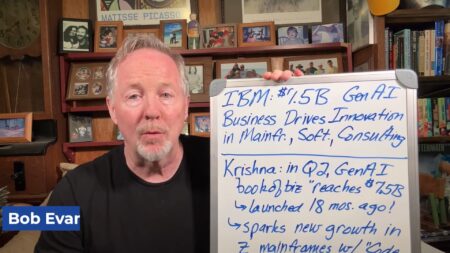
(Note: After an award-winning career in the media business covering the tech industry, Bob Evans was VP of Strategic Communications at SAP in 2011, and Chief Communications Officer at Oracle from 2012 to 2016. He now runs his own firm, Evans Strategic Communications LLC.)
CLOUD WARS — As the Cloud War’s leading rivals prepare to post Q3 financial results this week, Microsoft has an excellent chance to approach $7.5 billion in Q3 cloud revenue while Amazon is likely to flirt with $6.9 billion.
Three months ago, Microsoft widened its lead over Amazon in cloud revenue by reporting commercial-cloud of $6.9 billion, while Amazon Web Services posted revenue of $6.1 billion. (It’s worth noting that those blowout numbers for Microsoft were for its fiscal fourth quarter, when it traditionally reports outstanding numbers as it wraps up its fiscal year on June 30.)
For the past four quarters, you can see that in spite of Amazon’s superb performance in the enterprise cloud, Microsoft has not only matched but exceeded the stellar numbers Amazon has put up in the commercial-cloud sector:
- 3 months ending Sept. 30, 2017: Microsoft $5.0 billion, up 57%; Amazon $4.6 billion, up 42%;
- 3 months ending Dec. 31, 2017: Microsoft $5.3 billion, up 55%; Amazon $5.1 billion, up 44%;
- 3 months ending March 31, 2018: Microsoft $6.0 billion, up 57%; Amazon $5.4 billion, up 48%; and
- 3 months ending June 30, 2018: Microsoft $6.9 billion, up 58%; Amazon $6.1 billion, up 49%.
It is, quite simply, astonishing to see that even as both companies’ cloud businesses reach annualized run rates of more than $25 billion, their growth rates are increasing—surely a sign of not only the superb performance of both companies but also of the ravenous appetite among corporate customers for top-quality cloud-computing services.
Looking ahead to this week’s Q3 numbers, whatever the final details turn out to be, the biggest winners of all will be the corporate customers benefitting from near-endless streams of cloud and AI innovation from Amazon and Microsoft as those customers look to become end-to-end digital businesses.
For example, here’s a partial list of the new digital offerings Amazon rolled out in Q2:
- Enterprise customers including Ryanair and Epic Games going “all in on AWS”; 21st Century Fox moved most of its workloads to AWS to create digital consistency across its brands; Formula One shuttering most of its on-premises data centers in favor of AWS infrastructure while also standardizing on AWS machine-learning and data-analytics services; and Major League Baseball making a full commitment to AWS for machine learning, artificial intelligence, and deep learning.
- General availability of the Amazon Elastic Container Service; DeepLens, a deep-learning-enabled wireless video camera for developers; and Amazon Neptune, a graph database service.
- Amazon QuickSight, a business intelligence service with pay-per-session pricing.
- AWS Snowball Edge, a data-transfer edge with on-board storage and compute to move large amounts of data into and out of AWS.
In spite of that relentless flow of new cloud services from AWS, Microsoft remains the leading enterprise-cloud provider because it has been equally aggressive in pushing out a range of new and enhanced services from hyperscale infrastructure to digitally enhanced SaaS apps featuring HoloLens capabilities.
Here’s a summary of Azure’s recent enhancements as outlined by CEO Satya Nadella following Microsoft’s results from 3 months ago and reported in a Forbes.com article I posted in July:
“If [Nadella’s] right about the potential of intelligent cloud plus intelligent edge—and so far Nadella appears to be exactly that—he will force Amazon, IBM and others into trying to play catch-up. ‘Azure is the only hyperscale cloud that extends to the edge across identity, data, application platform, security and management,’ Nadella said. ‘We are investing aggressively to build Azure as the world’s computer.’ ”
Some of those aggressive buildouts include the following:
- An IaaS global footprint of 54 regions, which Microsoft says is more than any of the other hyperscale cloud providers offers;
- the rollout of Azure Stack for hybrid environments, which has been a huge early success;
- 500 new Azure capabilities in FY18;
- Azure Sphere to secure and manage IoT devices; and
- Azure Cognitive Services, Azure Machine Learning and Azure Cosmos DB.
Another highly strategic development for Microsoft has been the decision by huge global corporations to move their production-level SAP applications to the cloud, a trend that we noted several months ago in a Cloud Wars article. Here’s how Nadella described that during the Q2 earnings call:
“The one thing that I would say that I am increasingly seeing is Tier 1 workloads. In some sense, when you think about some of the commitments being made by some of the biggest brands in the world in terms of what they’re doing, one, it’s very core to their operation; and two, they are running it in the cloud. And so, that’s one thing that definitely is a market difference for us.”
We’ll get the final results from Microsoft on Wednesday, Oct. 24, and from Amazon on Thursday, Oct. 25.
*******************
RECOMMENDED READING FROM CLOUD WARS:
The World’s Top 5 Cloud-Computing Suppliers: #1 Microsoft, #2 Amazon, #3 Salesforce, #4 SAP, #5 IBM
Amazon Versus Oracle: The Battle for Cloud Database Leadership
As Amazon Battles with Retailers, Microsoft Leads Them into the Cloud
Why Microsoft Is #1 in the Cloud: 10 Key Insights
SAP’s Stunning Transformation: Qualtrics Already “Crown Jewel of Company”
Watch Out, Microsoft and Amazon: Google Cloud CEO Thomas Kurian Plans To Be #1
The Coming Hybrid Wave: Where Do Microsoft, IBM and Amazon Stand? (Part 1 of 2)
Oracle, SAP and Workday Driving Red-Hot Cloud ERP Growth Into 2019
*********************
My predictions for cloud revenue for the 3 months ending Sept. 30: for Microsoft, $7.4 billion; for Amazon, $6.85 billion.
I’ve analyzed and written about the enterprise-tech business for more than 20 years from the media side as an editor-in-chief and chief content officer, and more recently as Chief Communications Officer at Oracle from 2012-2016. I’ve written thousands of articles and columns… MORE
As businesses jump to the cloud to accelerate innovation and engage more intimately with customers, my Cloud Wars series analyze the major cloud vendors from the perspective of business customers.








